air condition FIAT FIORINO 2007 Owner handbook (in English)
[x] Cancel search | Manufacturer: FIAT, Model Year: 2007, Model line: FIORINO, Model: FIAT FIORINO 2007Pages: 210, PDF Size: 3.22 MB
Page 45 of 210
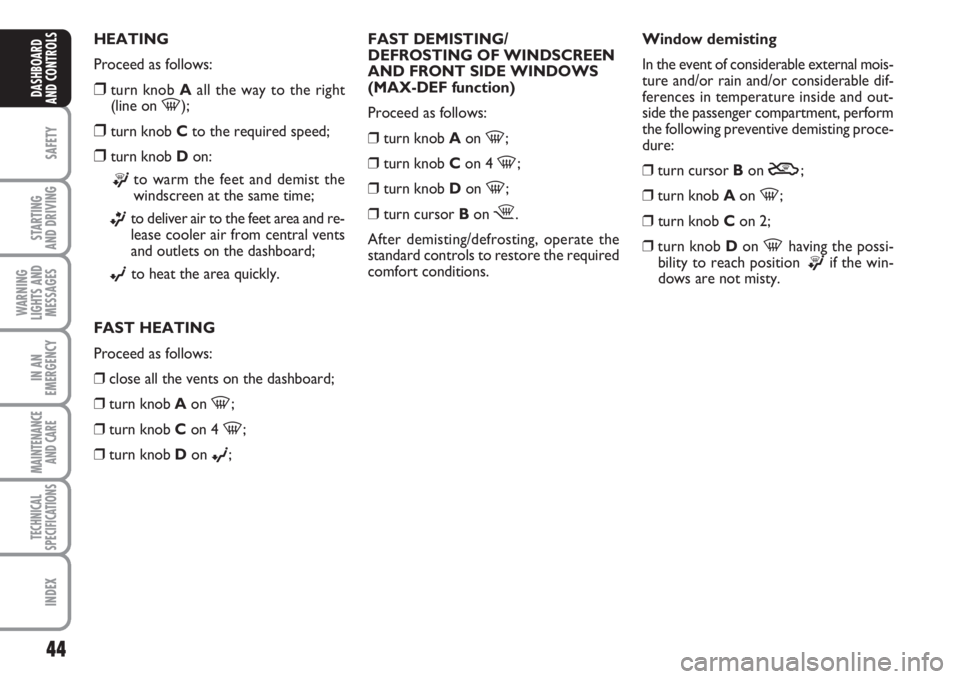
44
SAFETY
STARTING
AND DRIVING
WARNING
LIGHTS AND
MESSAGES
IN AN
EMERGENCY
MAINTENANCE
AND CARE
TECHNICAL
SPECIFICATIONS
INDEX
DASHBOARD
AND CONTROLS
HEATING
Proceed as follows:
❒turn knob Aall the way to the right
(line on -);
❒turn knob Cto the required speed;
❒turn knob Don:
®to warm the feet and demist the
windscreen at the same time;
ßto deliver air to the feet area and re-
lease cooler air from central vents
and outlets on the dashboard;
©to heat the area quickly.
FAST HEATING
Proceed as follows:
❒close all the vents on the dashboard;
❒turn knob Aon
-;
❒turn knob Con 4
-;
❒turn knob Don
©;FAST DEMISTING/
DEFROSTING OF WINDSCREEN
AND FRONT SIDE WINDOWS
(MAX-DEF function)
Proceed as follows:
❒turn knob Aon
-;
❒turn knob Con 4
-;
❒turn knob Don
-;
❒turn cursor Bon
¶.
After demisting/defrosting, operate the
standard controls to restore the required
comfort conditions.Window demisting
In the event of considerable external mois-
ture and/or rain and/or considerable dif-
ferences in temperature inside and out-
side the passenger compartment, perform
the following preventive demisting proce-
dure:
❒turn cursor Bon
Y;
❒turn knob Aon
-;
❒turn knob Con 2;
❒turn knob Don
-having the possi-
bility to reach position
®if the win-
dows are not misty.
Page 48 of 210
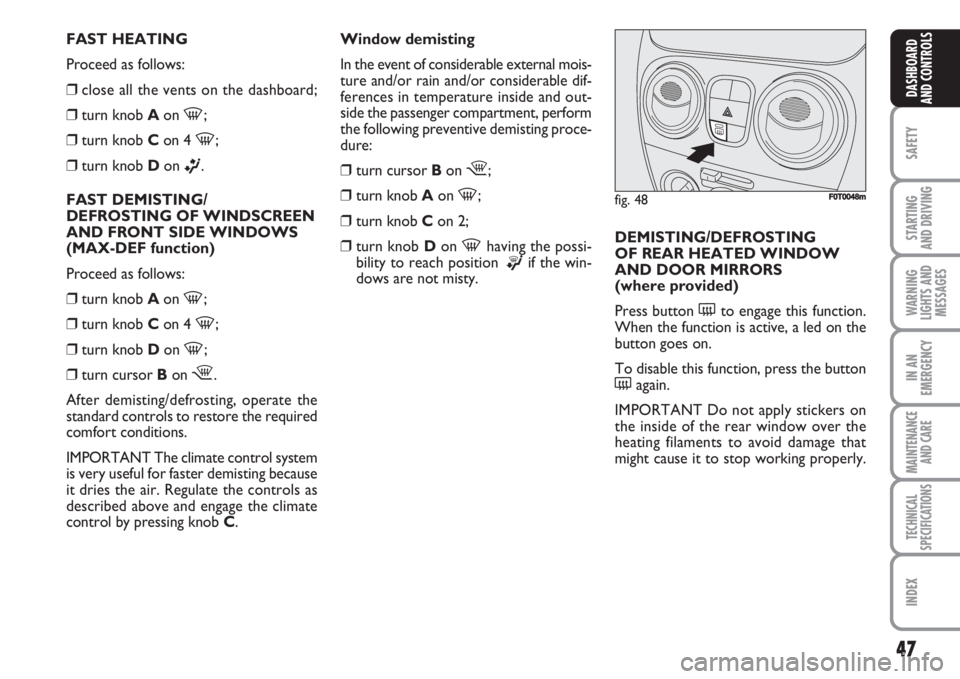
47
SAFETY
STARTING
AND DRIVING
WARNING
LIGHTS AND
MESSAGES
IN AN
EMERGENCY
MAINTENANCE
AND CARE
TECHNICAL
SPECIFICATIONS
INDEX
DASHBOARD
AND CONTROLS
FAST HEATING
Proceed as follows:
❒close all the vents on the dashboard;
❒turn knob Aon
-;
❒turn knob Con 4
-;
❒turn knob Don
ß.
FAST DEMISTING/
DEFROSTING OF WINDSCREEN
AND FRONT SIDE WINDOWS
(MAX-DEF function)
Proceed as follows:
❒turn knob Aon
-;
❒turn knob Con 4
-;
❒turn knob Don
-;
❒turn cursor Bon
¶.
After demisting/defrosting, operate the
standard controls to restore the required
comfort conditions.
IMPORTANT The climate control system
is very useful for faster demisting because
it dries the air. Regulate the controls as
described above and engage the climate
control by pressing knob C.Window demisting
In the event of considerable external mois-
ture and/or rain and/or considerable dif-
ferences in temperature inside and out-
side the passenger compartment, perform
the following preventive demisting proce-
dure:
❒turn cursor Bon
¶;
❒turn knob Aon
-;
❒turn knob Con 2;
❒turn knob Don
-having the possi-
bility to reach position
®if the win-
dows are not misty. DEMISTING/DEFROSTING
OF REAR HEATED WINDOW
AND DOOR MIRRORS
(where provided)
Press button (to engage this function.
When the function is active, a led on the
button goes on.
To disable this function, press the button
(again.
IMPORTANT Do not apply stickers on
the inside of the rear window over the
heating filaments to avoid damage that
might cause it to stop working properly.
fig. 48F0T0048m
Page 83 of 210
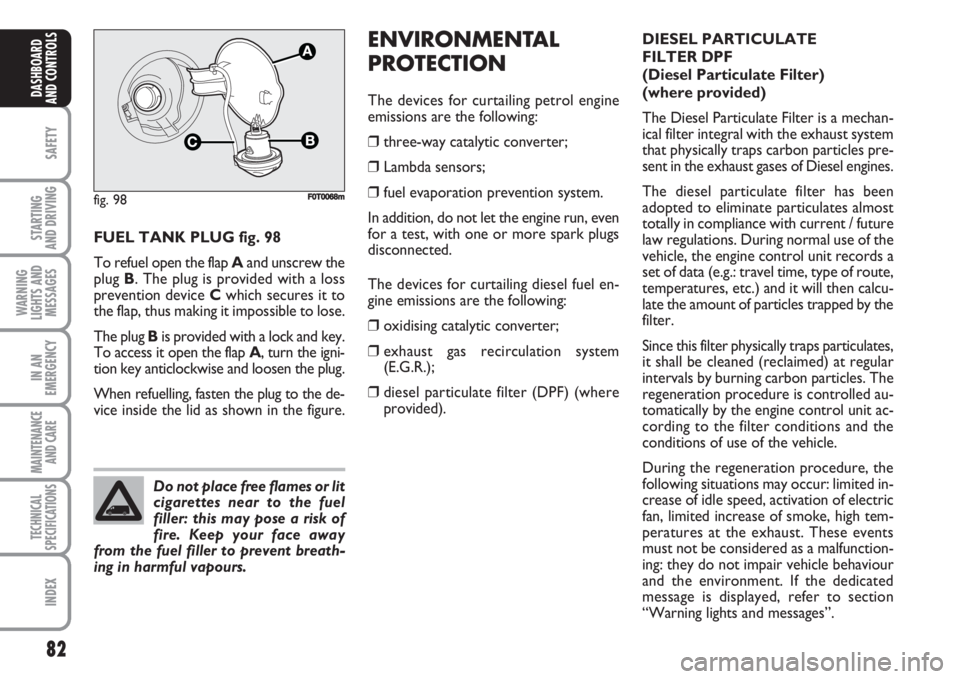
82
SAFETY
STARTING
AND DRIVING
WARNING
LIGHTS AND
MESSAGES
IN AN
EMERGENCY
MAINTENANCE
AND CARE
TECHNICAL
SPECIFICATIONS
INDEX
DASHBOARD
AND CONTROLS
FUEL TANK PLUG fig. 98
To refuel open the flap Aand unscrew the
plug B. The plug is provided with a loss
prevention device Cwhich secures it to
the flap, thus making it impossible to lose.
The plug Bis provided with a lock and key.
To access it open the flap A, turn the igni-
tion key anticlockwise and loosen the plug.
When refuelling, fasten the plug to the de-
vice inside the lid as shown in the figure.
ENVIRONMENTAL
PROTECTION
The devices for curtailing petrol engine
emissions are the following:
❒three-way catalytic converter;
❒Lambda sensors;
❒fuel evaporation prevention system.
In addition, do not let the engine run, even
for a test, with one or more spark plugs
disconnected.
The devices for curtailing diesel fuel en-
gine emissions are the following:
❒oxidising catalytic converter;
❒exhaust gas recirculation system
(E.G.R.);
❒diesel particulate filter (DPF) (where
provided).
fig. 98
C
A
F0T0068m
Do not place free flames or lit
cigarettes near to the fuel
filler: this may pose a risk of
fire. Keep your face away
from the fuel filler to prevent breath-
ing in harmful vapours.
DIESEL PARTICULATE
FILTER DPF
(Diesel Particulate Filter)
(where provided)
The Diesel Particulate Filter is a mechan-
ical filter integral with the exhaust system
that physically traps carbon particles pre-
sent in the exhaust gases of Diesel engines.
The diesel particulate filter has been
adopted to eliminate particulates almost
totally in compliance with current / future
law regulations. During normal use of the
vehicle, the engine control unit records a
set of data (e.g.: travel time, type of route,
temperatures, etc.) and it will then calcu-
late the amount of particles trapped by the
filter.
Since this filter physically traps particulates,
it shall be cleaned (reclaimed) at regular
intervals by burning carbon particles. The
regeneration procedure is controlled au-
tomatically by the engine control unit ac-
cording to the filter conditions and the
conditions of use of the vehicle.
During the regeneration procedure, the
following situations may occur: limited in-
crease of idle speed, activation of electric
fan, limited increase of smoke, high tem-
peratures at the exhaust. These events
must not be considered as a malfunction-
ing: they do not impair vehicle behaviour
and the environment. If the dedicated
message is displayed, refer to section
“Warning lights and messages”.
Page 162 of 210
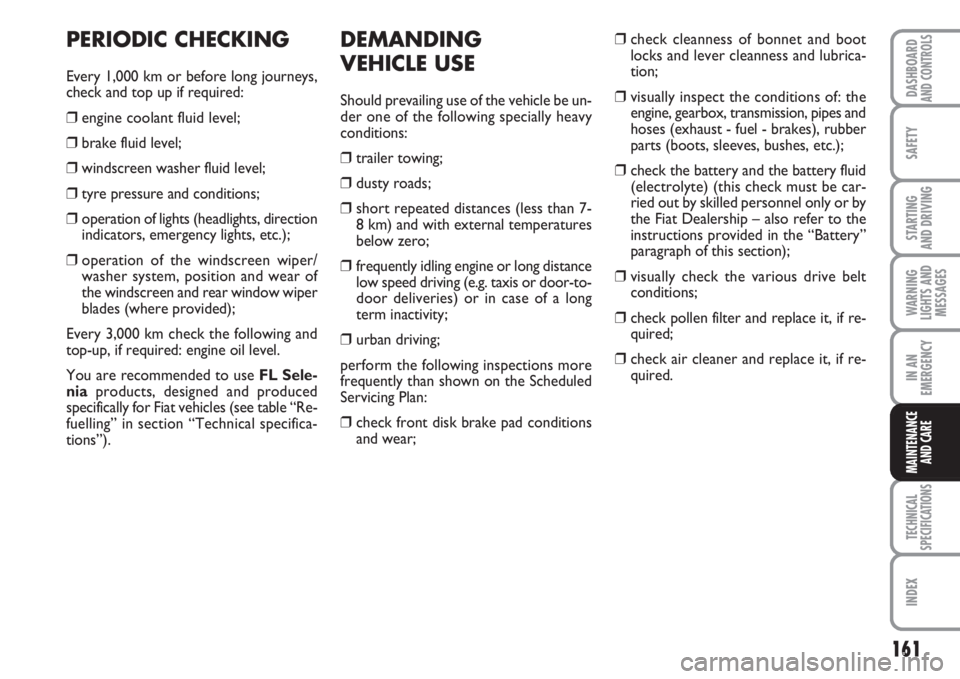
161
SAFETY
TECHNICAL
SPECIFICATIONS
INDEX
DASHBOARDAND CONTROLS
STARTING
AND DRIVING
WARNING
LIGHTS AND
MESSAGES
IN AN
EMERGENCY
MAINTENANCE
AND CARE
PERIODIC CHECKING
Every 1,000 km or before long journeys,
check and top up if required:
❒engine coolant fluid level;
❒brake fluid level;
❒windscreen washer fluid level;
❒tyre pressure and conditions;
❒operation of lights (headlights, direction
indicators, emergency lights, etc.);
❒operation of the windscreen wiper/
washer system, position and wear of
the windscreen and rear window wiper
blades (where provided);
Every 3,000 km check the following and
top-up, if required: engine oil level.
You are recommended to use FL Sele-
niaproducts, designed and produced
specifically for Fiat vehicles (see table “Re-
fuelling” in section “Technical specifica-
tions”).
DEMANDING
VEHICLE USE
Should prevailing use of the vehicle be un-
der one of the following specially heavy
conditions:
❒trailer towing;
❒dusty roads;
❒short repeated distances (less than 7-
8 km) and with external temperatures
below zero;
❒frequently idling engine or long distance
low speed driving (e.g. taxis or door-to-
door deliveries) or in case of a long
term inactivity;
❒urban driving;
perform the following inspections more
frequently than shown on the Scheduled
Servicing Plan:
❒check front disk brake pad conditions
and wear;❒check cleanness of bonnet and boot
locks and lever cleanness and lubrica-
tion;
❒visually inspect the conditions of: the
engine, gearbox, transmission, pipes and
hoses (exhaust - fuel - brakes), rubber
parts (boots, sleeves, bushes, etc.);
❒check the battery and the battery fluid
(electrolyte) (this check must be car-
ried out by skilled personnel only or by
the Fiat Dealership – also refer to the
instructions provided in the “Battery”
paragraph of this section);
❒visually check the various drive belt
conditions;
❒check pollen filter and replace it, if re-
quired;
❒check air cleaner and replace it, if re-
quired.
Page 168 of 210

167
SAFETY
TECHNICAL
SPECIFICATIONS
INDEX
DASHBOARDAND CONTROLS
STARTING
AND DRIVING
WARNING
LIGHTS AND
MESSAGES
IN AN
EMERGENCY
MAINTENANCE
AND CARE
AIR CLEANER/
POLLEN FILTER
Have the air cleaner or the pollen filter re-
placed by a Fiat Dealership.
BATTERY
The vehicle fits a low-maintenance battery:
no top-ups with distilled water are need-
ed in normal conditions of use.
A periodic check is however required to
make sure that the battery is in efficient
conditions. Have it performed by the Fiat
Dealership or skilled personnel only. REPLACING THE BATTERY
If required, replace the battery with a gen-
uine spare battery having the same speci-
fications.
If a battery with different specifications is
fitted, the service intervals given in the
“Scheduled servicing plan” in this section
will no longer be valid.
Follow the battery manufacturer’s in-
structions for maintenance.
The battery fluid is poiso-
nous and corrosive. Avoid
contact with the skin and eyes. Keep
naked flames and sources of sparks
away from the battery: risk of explo-
sion and fire.
WARNING
Running the battery with an
excessively low liquid level
will damage the battery beyond re-
pair and even cause an explosion.
WARNING
Incorrect assembly of electric
and electronic devices may
cause severe damage to your
vehicle. Go to a Fiat Dealer-
ship if, after buying the vehicle, you
want to install accessories (alarms, mo-
bile phone, etc.): they will suggest the
most suitable devices and advise you
if a higher capacity battery needs to be
installed.
Page 174 of 210
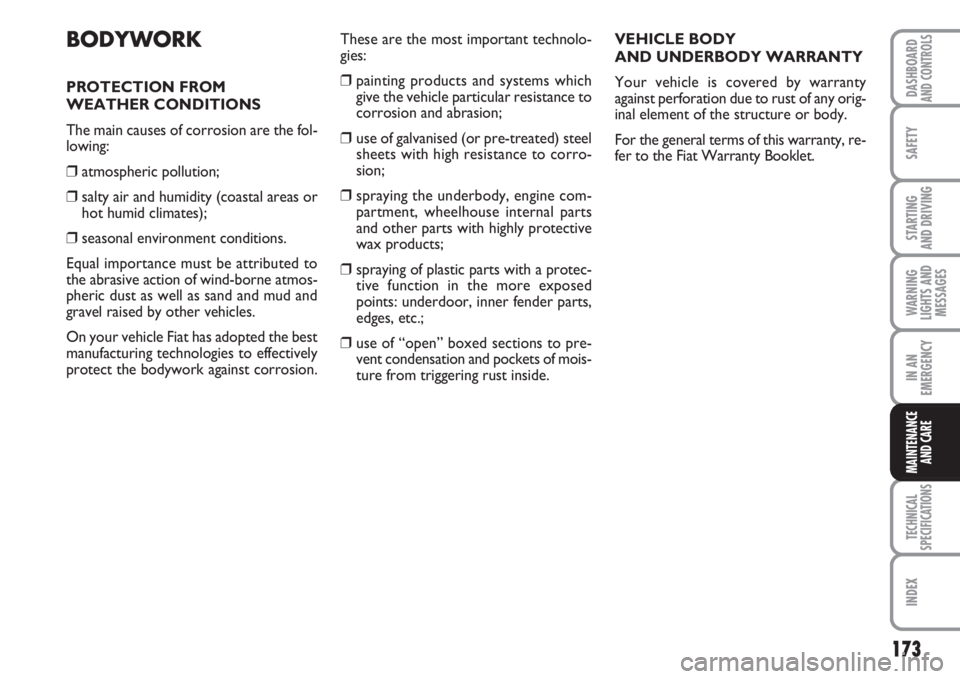
173
SAFETY
TECHNICAL
SPECIFICATIONS
INDEX
DASHBOARDAND CONTROLS
STARTING
AND DRIVING
WARNING
LIGHTS AND
MESSAGES
IN AN
EMERGENCY
MAINTENANCE
AND CARE
BODYWORK
PROTECTION FROM
WEATHER CONDITIONS
The main causes of corrosion are the fol-
lowing:
❒atmospheric pollution;
❒salty air and humidity (coastal areas or
hot humid climates);
❒seasonal environment conditions.
Equal importance must be attributed to
the abrasive action of wind-borne atmos-
pheric dust as well as sand and mud and
gravel raised by other vehicles.
On your vehicle Fiat has adopted the best
manufacturing technologies to effectively
protect the bodywork against corrosion.These are the most important technolo-
gies:
❒painting products and systems which
give the vehicle particular resistance to
corrosion and abrasion;
❒use of galvanised (or pre-treated) steel
sheets with high resistance to corro-
sion;
❒spraying the underbody, engine com-
partment, wheelhouse internal parts
and other parts with highly protective
wax products;
❒spraying of plastic parts with a protec-
tive function in the more exposed
points: underdoor, inner fender parts,
edges, etc.;
❒use of “open” boxed sections to pre-
vent condensation and pockets of mois-
ture from triggering rust inside.VEHICLE BODY
AND UNDERBODY WARRANTY
Your vehicle is covered by warranty
against perforation due to rust of any orig-
inal element of the structure or body.
For the general terms of this warranty, re-
fer to the Fiat Warranty Booklet.
Page 175 of 210
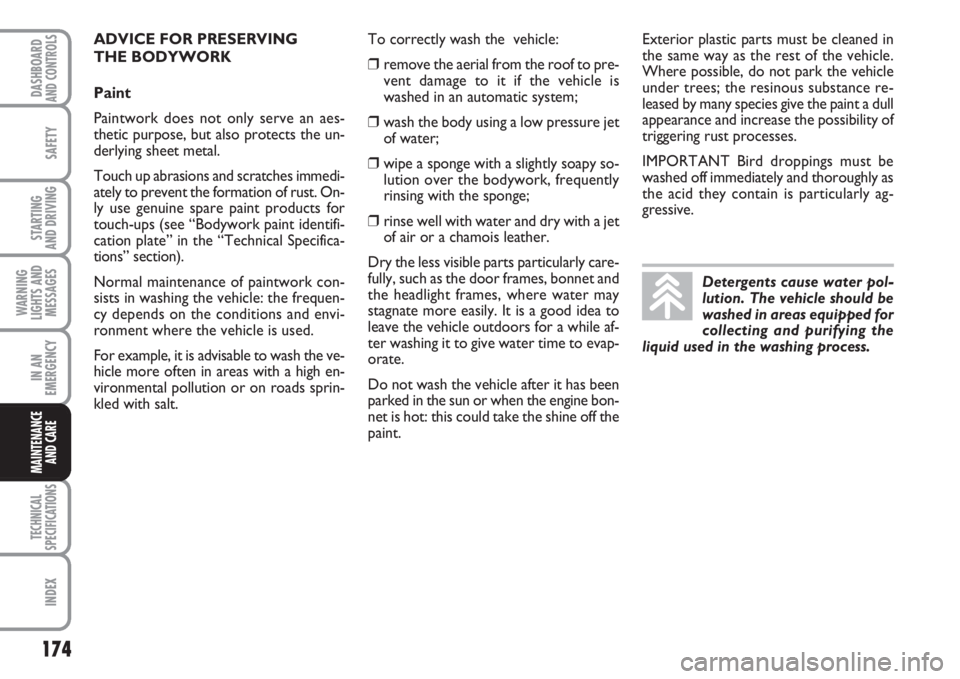
174
SAFETY
TECHNICAL
SPECIFICATIONS
INDEX
DASHBOARDAND CONTROLS
STARTING
AND DRIVING
WARNING
LIGHTS AND
MESSAGES
IN AN
EMERGENCY
MAINTENANCE
AND CARE
ADVICE FOR PRESERVING
THE BODYWORK
Paint
Paintwork does not only serve an aes-
thetic purpose, but also protects the un-
derlying sheet metal.
Touch up abrasions and scratches immedi-
ately to prevent the formation of rust. On-
ly use genuine spare paint products for
touch-ups (see “Bodywork paint identifi-
cation plate” in the “Technical Specifica-
tions” section).
Normal maintenance of paintwork con-
sists in washing the vehicle: the frequen-
cy depends on the conditions and envi-
ronment where the vehicle is used.
For example, it is advisable to wash the ve-
hicle more often in areas with a high en-
vironmental pollution or on roads sprin-
kled with salt.To correctly wash the vehicle:
❒remove the aerial from the roof to pre-
vent damage to it if the vehicle is
washed in an automatic system;
❒wash the body using a low pressure jet
of water;
❒wipe a sponge with a slightly soapy so-
lution over the bodywork, frequently
rinsing with the sponge;
❒rinse well with water and dry with a jet
of air or a chamois leather.
Dry the less visible parts particularly care-
fully, such as the door frames, bonnet and
the headlight frames, where water may
stagnate more easily. It is a good idea to
leave the vehicle outdoors for a while af-
ter washing it to give water time to evap-
orate.
Do not wash the vehicle after it has been
parked in the sun or when the engine bon-
net is hot: this could take the shine off the
paint.Exterior plastic parts must be cleaned in
the same way as the rest of the vehicle.
Where possible, do not park the vehicle
under trees; the resinous substance re-
leased by many species give the paint a dull
appearance and increase the possibility of
triggering rust processes.
IMPORTANT Bird droppings must be
washed off immediately and thoroughly as
the acid they contain is particularly ag-
gressive.
Detergents cause water pol-
lution. The vehicle should be
washed in areas equipped for
collecting and purifying the
liquid used in the washing process.
Page 195 of 210
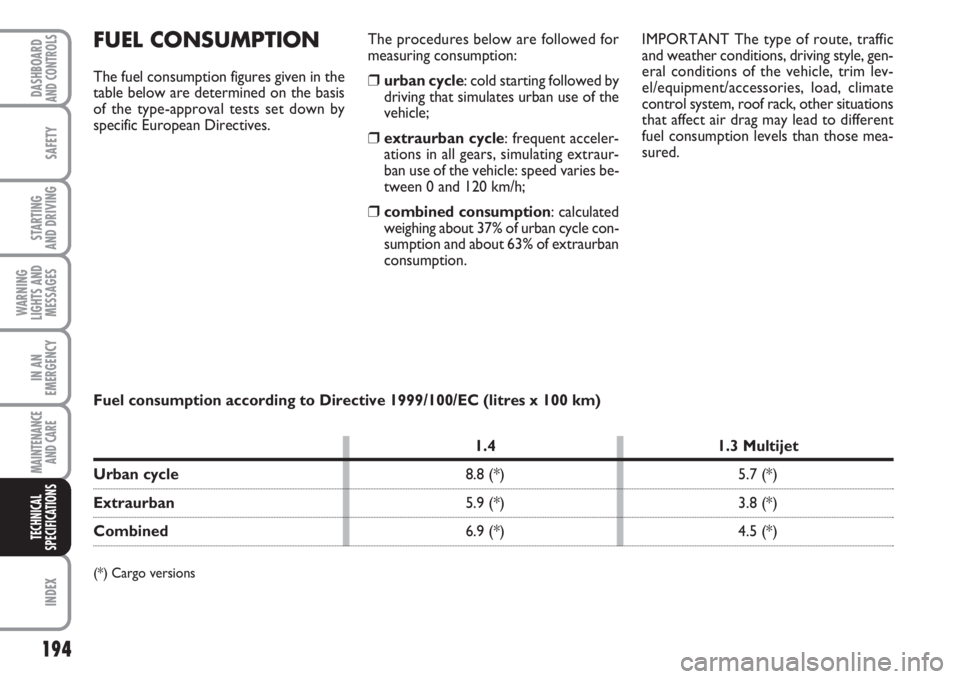
194
SAFETY
INDEX
DASHBOARDAND CONTROLS
STARTING
AND DRIVING
WARNING
LIGHTS AND
MESSAGES
IN AN
EMERGENCY
MAINTENANCE
AND CARE
TECHNICAL
SPECIFICATIONS
FUEL CONSUMPTION
The fuel consumption figures given in the
table below are determined on the basis
of the type-approval tests set down by
specific European Directives. IMPORTANT The type of route, traffic
and weather conditions, driving style, gen-
eral conditions of the vehicle, trim lev-
el/equipment/accessories, load, climate
control system, roof rack, other situations
that affect air drag may lead to different
fuel consumption levels than those mea-
sured. The procedures below are followed for
measuring consumption:❒urban cycle: cold starting followed by
driving that simulates urban use of the
vehicle;
❒extraurban cycle: frequent acceler-
ations in all gears, simulating extraur-
ban use of the vehicle: speed varies be-
tween 0 and 120 km/h;
❒combined consumption: calculated
weighing about 37% of urban cycle con-
sumption and about 63% of extraurban
consumption.
Fuel consumption according to Directive 1999/100/EC (litres x 100 km)
1.4 1.3 Multijet
Urban cycle8.8 (*) 5.7 (*)
Extraurban5.9 (*) 3.8 (*)
Combined6.9 (*) 4.5 (*)
(*) Cargo versions